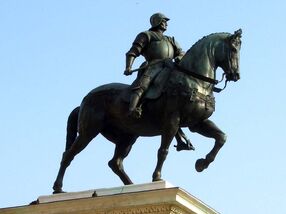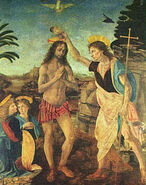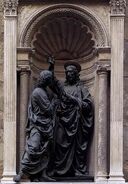Andrea del Verrocchio (~1435-1488) was an Italian artist of the early Renaissance praised especially for his

sculptures. Many other famous artists, such as Leonardo da Vinci, studied under him in his studio. Verrocchio hardly did anything by himself; much of his work was done with collaboration from pupils and contemporaries. His work is well-known for its spiral shapes, indicating life, energy, and movement in many of his statues. Similarly, many praise that his statues captured more nuanced emotions than many other sculptures of his time, such as the smirk on David's face with the head of Goliath at his feet or the tenderness when Thomas is feeling Jesus's side.
Significance to Stevens[]
In Stevens's work of prose, The Necessary Angel, he wrote of many images of nobility and highlighted Verrocchio's equestrian statue of Bartolomeo Colleoni in Venice as a prime example of masculinity, going against other mighty figures like "a pair of winged horses and a charioteer" in Plato's Phaedrus, Cervantes 's Don Quixote, General Andrew Jackson in front of the White House, and the rider in Reginald Marsh's Wooden Horse (Holander 95-97):

Verrocchio's equestrian statue of Bartolomeo Colleoni
"I have not selected him as a Neo-Platonist to relate us back from a modern time to Plato's time, although he does in fact so relate us, just as through Leonardo, his pupil, he strengthens the relationship. I have selected him because there, on the edge of the world in which we live today, he established a form of such nobility that is has never ceased to magnify us in our own eyes. It is like the form of an invincible man, who has come, slowly and boldly, through every warlike opposition of the past and who moves in our midst without dropping the bridle of the powerful horse from his hand, without taking off his helmet and without relaxing the attitude of a warrior of noble origin. Wha tman on whose side the horseman fought could ever be anything but fearless, anything but indomitable? ... It seems, nowadays, what it may very well not have seemed a few years ago, a little overpowering, a little magnificent" (Stevens 8).
No doubt Stevens wrote these words with the current war in mind that the United States was soon about to enter (Woodland 51-52). Stevens's perception of Verrocchio's Colleoni is almost too grand; it does not have enough realism to it (Holander 95). Compared to Cervantes's work that balances imagination and reality, Verrocchio's vision is genius--but too ideal: "With Cervantes, nobility was not a thing of the imagination. It was a part of reality, it was something that exists in life, something so true to us that it is in danger of ceasing to exist, if we isolate it, something in the mind of a precarious nature. These may be words. Certainly, however, Cervantes sought to set right the balance between the imagination and the reality" (Stevens 9-10). Verrocchio, in Stevens's mind, had lost sight of "the base."
Sources and Further Reading[]
The National Gallery's Verrocchio page
Web Gallery of Art's Verrocchio page
Wallace Stevens and the Apocalyptic Mode, by Malcolm Woodland, on Google Books
Wallace Stevens and the Realities of Poetic Language, by Stefan Holander, on Google Books






